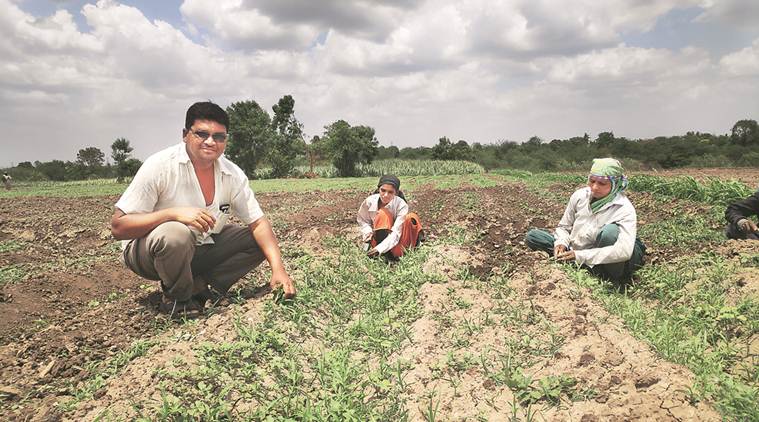- India
- International
GM cotton crop technology: The cost of weeding
Maharashtra’s farmers want to plant herbicide-tolerant cotton, with or without government approval.
 Sitaram Amrut Jadhav with labourers removing weeds at his cotton field in Tilapur village of Ahmednagar district. (Express photo: Partha Sarathi Biswas)
Sitaram Amrut Jadhav with labourers removing weeds at his cotton field in Tilapur village of Ahmednagar district. (Express photo: Partha Sarathi Biswas)
Sitaram Amrut Jadhav is busy arranging plastic bags for covering his cotton plants on three acres.
“They will help me spray glyphosate (a chemical herbicide) to kill all the weeds growing between the rows, without destroying the plants,” explains the 47-year-old farmer from Tilapur village in Rahuri taluka of Ahmednagar district. But this stratagem can work only for the plants that are neither too small nor tall. “It’s not possible to cover those that are of less than 5 cm height or have grown beyond one foot (30 cm). For these, I cannot use glyphosate and will have to rely on manual labour for removing the weeds,” he adds.
Jadhav sowed the cotton on his three acres, which have irrigation facility, towards end-May. He’s now waiting for the monsoon rains to plant cotton on another 11 acres out of his total 30-acre holding, which also includes 15 acres under sugarcane and one acre under fodder crops. Last year, Jadhav harvested an average 18 quintals of kapas (raw un-ginned cotton) per acre — much more than the 10-12 quintals yields of most farmers — and realised a rate of around Rs 5,800/quintal. “I am optimistic about bhav (prices) this time, too. My only worry is paani (water) and taan (weeds),” he adds.
Also Read | Farmer held in Maharashtra for sale of Ht Bt cotton seeds
The desperation to control taan also accounts for an ongoing “Civil Disobedience Movement” among farmers — especially in districts such as Akola, Yavatmal and Parbhani — to illegally cultivate genetically modified (GM) herbicide-tolerant or HT cotton. This cotton contains a ‘cp4-epsps’ gene isolated from a soil bacterium Agrobacterium tumefaciens, which produces a modified protein that allows the plant to tolerate application of glyphosate. Thus, while farmers cannot spray glyphosate on normal cotton, as the chemical cannot distinguish between weeds and the crop itself, they can do it in HT cotton.

On June 10, over 1,000 farmers gathered at Akoli Jahangir, a village in Akola’s Akot taluka, to plant HT cotton that is an “approved” GM event — unlike Bt cotton, which incorporates ‘cry1Ac’ and ‘cry2Ab’ genes from the Bacillus thuringiensis soil bacterium, coding for protein toxic to various bollworm insect pests.
Also Read | GM cotton: what is allowed, what farmers sowed
More than 300 km from Akola, cotton growers here unequivocally support the Civil Disobedience Movement led by Shetkari Sanghatana, an organisation founded by the late farmer leader Sharad Joshi. “We need a solution for taan. If it comes from GM, why not?,” quips Jadhav.
Cotton is far more susceptible to weeds than crops like sugarcane or soyabean. The reason for it is the wide spacing requirement: Farmers typically maintain a four-foot (120 cm) distance between two rows and two feet (60 cm) from plant to plant. This is as against the much denser spacing in soyabean — 1.5 feet (45 cm) row-to-row and 0.5 feet (15 cm) plant-to-plant — that gives hardly any room for weeds to grow. “In cane, the spacing is more or less that of cotton. But since the plant is sturdier, I can use chemical herbicides such as Atrazine and Oxyfluorfen or power weeder/tiller to control the weeds,” points out Jadhav.
In cotton, farmers have to wage war against weeds right from three weeks after sowing, when the crop is in the early-leaf stage and the plants barely five cm tall. “You need at least 10 labourers per acre and they have to be paid a daily wage rate of Rs 250 each. In the entire crop cycle of 180-odd days, there will be minimum four rounds of manual weeding — after three weeks, five weeks, seven weeks (before square or fruiting-bud formation) and 10 weeks (before start of flowering). The total weeding cost will be
Rs 10,000 per acre,” states Jadhav. This is a cost that has to be borne; the alternative is yield losses from the weeds competing with the crop for nutrients, water and sunlight.
For Shamrao Pawar, who grows cotton on 4 out of his 12 acres land in the neighbouring village of Wanjulpoi, it’s not simply the cost, but timely availability of weeding labour that is a challenge. “Ten years ago, if I wanted five hands, 10 would turn up. Today, not even two will come,” he claims. Pawar’s field — his crop was also sown in the last week of May — is already full of weeds. With labour difficult to find, he and his brother, along with other family members, have taken up the work of weed removal themselves.
The most common weeds that grow between the rows and plants of cotton include Echinochloa (barnyard grass) and Cyperus rotundus (nut grass). Apart from these grassy weeds, there are broad-leaved weeds such as Amaranthus and Parthenium. As a broad-spectrum herbicide, glyphosate is effective against all of them. “We just need to apply one litre per acre. The chemical costs Rs 400, while the male labourers spraying it have to be paid another Rs 400. But this is still one-third the cost of manual weeding (Rs 2,500/acre). Unfortunately, with the existing (non-HT) hybrids, glyphosate can be sprayed only once, for the second round when the crop is five weeks old. We cannot use it once the plants are more than one foot tall,” notes Pawar.
Pawar ranks the costs of weeding ahead of even picking. Picking labourers charge Rs 8-10 per kg. For an average 14 quintals yield, that translates into Rs 11,000-14,000 per acre. “But that cost is relatively predictable. During July-August, when it is rains and taan growth is most rampant, weeding labour is next to impossible to get. At times, we have to bring them from faraway places and pay for their transport — or risk allowing the taan to take over our fields,” he remarks.
Besides weeding and picking, the other major costs for cotton growers are field preparation (Rs 7,000), fertilisers (Rs 3,000 per acre), insecticides (Rs 2,000, mainly for sucking pests like aphids, thrips, jassids and white fly) and seed (Rs 1,095). They all add up to roughly Rs 35,000 per acre. At 14 quintals yield and Rs 5,800/quintal realisation, the returns per acre work out to Rs 46,000 or so.
Either way, one thing is clear: Cotton growers don’t need to be told about the benefits of HT cotton. They would want to plant it, with or without the government’s approval.
Apr 26: Latest News
- 01
- 02
- 03
- 04
- 05








































